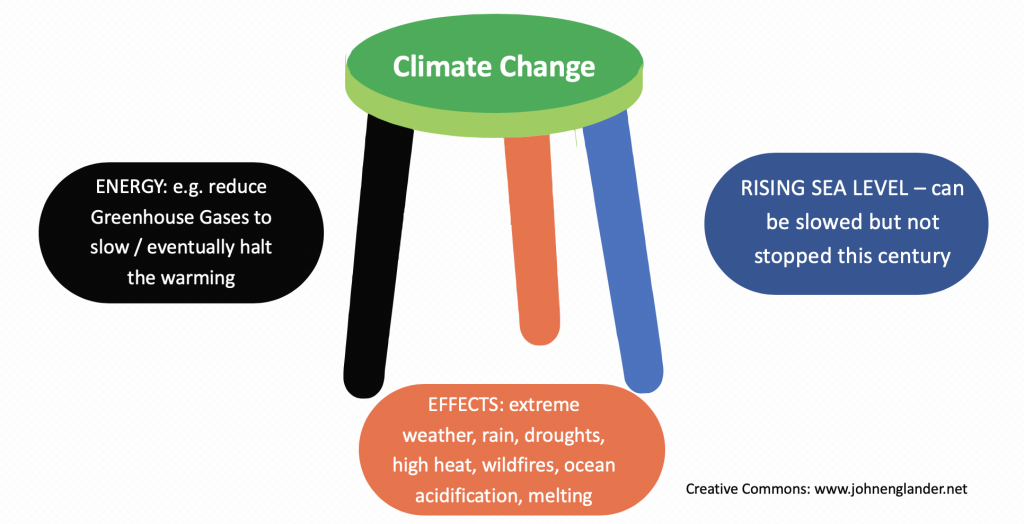Climate-Change: 3 Legs / 3 Feet

“Climate Change” is now widely recognized as an extremely serious problem. Yet there is a lot of confusion even when experts discuss “solutions.” One reason for the confusion is that there are three distinct aspects or legs of the climate change problem. Each of the three requires a very different solution:
#1. Reducing the greenhouse gases (“GHG”) particularly carbon dioxide (CO2), the by-product of burning fossil fuels. CO2 is now at 410 PPM (parts per million) a level that is 40% higher than the last few million years. CO2 has been known to be a “greenhouse gas” for almost two centuries and understood to trigger global warming. Huge efforts by millions of researchers worldwide are now focused on ways to drastically slow the use of fossil fuels, through energy efficiency and use of renewable sources. Other important efforts include ways to pull CO2 out of the atmosphere. More radical solutions are looking at ways to reduce the amount of sunlight that reaches Earth. All of these efforts to slow the warming are extremely important. As a category, they are often referred to as SUSTAINABILITY.
#2. Preparing for the EFFECTS of a warmer planet, such as extreme weather, including record-rainfall, greater downhill runoff, severe drought, high heat, wildfires, ocean acidification, melting glaciers, etc. In turn, these effects impact agriculture, water supply, infrastructure, and the viability of modern society. Efforts to prepare for and recover from such severe events are often referred to as RESILIENCY.
#3. Rising sea level is an effect of climate change, but is different from the effects described in #2. Rising sea level is not an event that suddenly affects a location. It is a long-term, slow, change to global ocean levels. Rather than being a sudden flood event that hits and recedes, rising sea level is the unrelenting increase of global ocean volume as the ice on land melts and enters the sea as meltwater or a new iceberg, both of which raise global sea level. (In addition the warming of the oceans also raises sea level through a phenomenon called thermal expansion of seawater.) Rising sea level will also increase flooding from events such as hurricanes, extreme rainfall and runoff, and extreme high tides, sometimes called king tides. The difference is that the short-term flood events recede, usually in hours and days, allowing a recovery to the pre-flood situation, even though flooding can cause devastation. Slowly rising sea level does not get our attention the same way that deadly flood events do.
As sea level rises inch by inch and foot by foot, in the coming decades, it becomes a new baseline. Sea level determines global shorelines. As sea level rises, it will work to reshape every coastal community in the world. Over the course of this century it will permanently destroy trillions of dollars of real estate and infrastructure and displace hundreds of millions of people posing humanitarian and national security challenges yet unimaginable. Preparing for rather-permanent higher sea level is quite different than preparing for short term flooding events. Rising sea level requires ADAPTATION.
There is a connection to the three problems of course. The better the world is at #1, slowing the warming through the reduction of greenhouse gases, the effects of #2 and #3 will eventually be reduced. The fact is however, that even if the world stopped using fossil fuels this instant, the effects of the excess heat, mostly stored in the ocean, will affect climate for decades; in fact throughout this century.
The latest estimates are that if we do everything possible to slow the warming (#1) – meaning a global all-out maximum effort, that we may be able to limit sea level rise this century to perhaps three feet (a meter). If we do nothing to slow the rise in carbon dioxide, the exponential warming, melting ice, and rising sea level could be more than twice that level.
In my consulting work and briefings, my simplest guideline is that communities should prepare for the first three feet (meter) of sea level rise as soon as possible. Adaptation needs to happen simultaneously with efforts to be more sustainable and more resilient. Three connected problems requiring three solutions.
